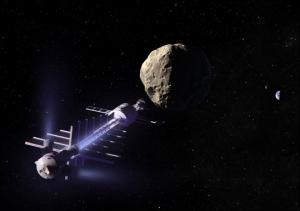The Discovery Channel’s news site offers a brief story about changing the course of an Earth-threatening asteroid. Specifically, the story focuses on a paper in the November 10 issue of Nature by Edward Lu and Stanley Love that offers a new method of avoiding an impact without even touching the asteroid. Previous options had included docking a spacecraft to the asteroid and applying steady thrust to change its course, but that method seems like a long-shot considering how tricky it is to get a conventional rocket to such an object with fuel to spare for an extended burn.
 What Lu and Love discuss is a 20-ton spacecraft that would actually use the weak gravitational force between asteroid and ship to effect a change in the asteroid’s orbit. In essence, the spacecraft would use nuclear-electric thrusters to maintain a fixed position above the asteroid. If such a mission were flown years in advance of an asteroid impact, the force exerted should be enough to change the expected impact into a not-so-near miss.
What Lu and Love discuss is a 20-ton spacecraft that would actually use the weak gravitational force between asteroid and ship to effect a change in the asteroid’s orbit. In essence, the spacecraft would use nuclear-electric thrusters to maintain a fixed position above the asteroid. If such a mission were flown years in advance of an asteroid impact, the force exerted should be enough to change the expected impact into a not-so-near miss.
Image: A space tractor at work, using nuclear-electric propulsion to establish a fixed position above an asteroid. Credit: Dan Durda/FIAAA/B612 Foundation.
The paper is Lu, Edward and Love, Stanley G., “Gravitational tractor for towing asteroids,” Nature Vol. 438, pp. 177-178 (10 November 2005). An abstract can be found here.
Centauri Dreams‘ take: The use of gravity as a ‘towline’ is ingenious and just the kind of realistic thinking we need when contemplating a potential mission of this magnitude. Conventional rocketry simply isn’t up to the challenge, but nuclear electric propulsion is theoretically sound and capable of maintaining the kind of low levels of thrust needed for asteroid station-keeping.
But another issue is at work here. Such gravitational nudging will only work if we can reach Earth-threatening objects well in advance of potential impacts. That calls for beefed up detection systems for objects that might threaten the planet, and also robust research into advanced propulsion to get us to such objects in a hurry, even if we initially detect them a long way from Earth. Closer to home, a mission like that envisioned by Lu and Love could conceivably be used to deflect the course of asteroid 99942 Apophis, which will make a near miss in 2029 and could threaten the Earth again in 2036.
As always, the B612 Foundation deserves your attention for its work in educating the public about potential asteroid collisions. And be aware that the testimony of B612’s Rusty Schweickart and Edward Lu before the Senate Subcommittee on Science, Technology, and Space of the Senate Commerce Committee (7 April 2004) is available along with other papers on the B612 Foundation’s news page.


a 20 ton object will not have gravitation strong enough to significantly
change the path of an asteroid in space . Its ingenuis but it its not
practical or realistic. asteroids mass millions , billions, and trillions
and qaudrillions of tons .
The 50 megaton russian/soviet Czar bomba however had a mass of 20 tons, and it was designed to be delivered by the Proton Booster . It can muster
enough power to deflect an asteroid unlike the 20 ton garavity tractor
idea.
‘Gravity tractor’ could deflect asteroids
New Scientist Space July 28, 2008
*************************
A study by NASA’s Jet Propulsion
Laboratory shows that the weak
gravitational pull of a nearby
spacecraft could deflect a
hypothetical asteroid 140 meters
across, big enough to cause regional
devastation if it hit Earth….
http://www.kurzweilai.net/email/newsRedirect.html?newsID=9147&m=25748
Oct 15, 2010
How to Deflect an Asteroid with Today’s Technology
by Nancy Atkinson
Apollo 9 astronaut Rusty Schweickart is among an international group of people championing the need for the human race to prepare for what will certainly happen one day: an asteroid threat to Earth. In an article on Universe Today published yesterday, Schweickart said the technology is available today to send a mission to an asteroid in an attempt to move it, or change its orbit so that an asteroid that threatens to hit Earth will pass by harmlessly. What would such a mission entail?
In a telephone interview, Schweickart described two types of “deflection campaigns” for a threatening asteroid: a kinetic impact would roughly “push” the asteroid into a different orbit, and a gravity tractor would “tug slowly” on the asteroid to precisely “trim” the resultant change course by using nothing more than the gravitational attraction between the two bodies. Together these two methods comprise a deflection campaign.
Full article here:
http://www.universetoday.com/75816/how-to-deflect-an-asteroid-with-today%e2%80%99s-technology/